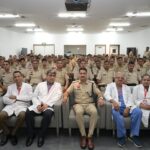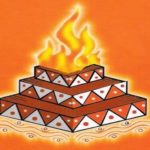India
healthysoch.com
New Delhi, September 29, 2019 :
World Heart Day : To mark this day, Heart Care Foundation of India (HCFI) and Medlife have joined hands to train over 2000 people in the life-saving technique of hands-only CPR 10. Medlife is India’s largest e-health platform.
As a part of the #BecauseHeartMatters campaign, over 40 physical trainings were conducted in more than 30 offices across 5 cities in a span of two weeks.
Sudden cardiac arrest (SCA) is a leading cause of cardiovascular death. More than 90% of cardiac arrests are “out of hospital cardiac arrests” and occur at home and less than 8% of these patients survive. The administration of CPR by a layperson bystander (bystander CPR or bystander-initiated CPR) is important in determining patient outcome after out-of-hospital SCA. A first-responder CPR may help revive the person until medical help arrives or a defibrillator is available. Almost 50% deaths due to these cardiac arrests could have been prevented if someone had performed CPR immediately.
Evidence has shown that survival after SCA is higher among those who have bystander CPR when compared with those who initially receive CPR from EMS personnel. For adults with sudden out-of-hospital cardiac arrest, compression-only bystander CPR (without rescue breathing) has equal or possibly greater efficacy compared with standard bystander CPR (compressions + rescue breathing).
There is enough evidence to suggest that CPR is effective in the first 10 minutes of cardiac arrest with maximum chances of reversibility if done in the first 10 minutes
To train people in this life saving technique, HCFI has created the hands-only CPR 10 mantra, which is extremely simple to remember. It is easy to learn and easy to do as it does not require mouth-to-mouth breathing unless the victim has died due to drowning or is a small child.
What each one of us needs to remember is the CPR 10 mantra “within 10 minutes of death (earlier the better), for a minimum of 10 minutes (the longer the better), compress the center of the chest of the deceased person continuously and effectively with a speed of 10×10 = at least 100 per minute”. Chest compressions should be stopped only when the person starts breathing or medical help arrives with automated external defibrillator (AED) machine.
Hands-only or compression-only CPR is done without mouth-to-mouth breaths and thus alleviates the anxiety of bystanders who are reluctant to perform mouth-to-mouth resuscitation because they harbor a fear of contracting a communicable disease or are apprehensive of performing the standard CPR correctly as they might not have been trained in it. Hands-only CPR is an effective option, especially when there is only a single lay rescuer.
Everyone should learn this life-saving technique.
About hands-only CPR
- When multiple trained personnel are present, the simultaneous performance of continuous excellent chest compressions and proper ventilation using a 30:2 compression to ventilation ratio is recommended for the management of sudden cardiac arrest
- The importance of ventilation increases with the duration of the arrest.
- However, if a sole lay rescuer is present or multiple lay rescuers are reluctant to perform mouth-to-mouth ventilation go for CPR using excellent chest compressions alone
- Rescuers should not interrupt excellent chest compressions to palpate for pulses or check for the return of spontaneous circulation and should continue CPR until an AED is ready to defibrillate, EMS personnel assume care, or the patient wakes up.
- Chest compression CPR is not recommended for children or arrest of noncardiac origin (eg, near drowning).
- For many would-be rescuers, the requirement to perform mouth-to-mouth ventilation is a significant barrier to the performance of CPR. This reluctance may stem from fear of contracting a communicable disease, despite scant reports of infection contracted from the performance of mouth-to-mouth ventilation, none of which involve HIV
- It may also be due to anxiety about performing CPR correctly. Hands only CPR circumvents these problems, potentially increasing the willingness of bystanders to perform CPR. (Excerpts Uptodate)







